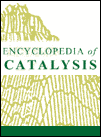Magnesium Enzymes and Models
Abstract
Most enzymes used in nucleic acid biochemistry, and many enzymes involved in general metabolism, require divalent magnesium as an essential activator. The selection of magnesium reflects the relatively high intracellular abundance of this ion, and its mechanism of action is tuned to the specific physicochemical properties that characterize its solution chemistry. In turn, this has required refinement of the protein environment to bind Mg2+ efficiently, and in a manner that preserves its catalytic integrity. This review summarizes what is known concerning the role of divalent magnesium as a mediator of enzymatic activity, and discusses this role in the context of the unique chemical properties of this metal cofactor. Mechanistic models and approaches that have been developed to understand these biological reactions are summarized, and a comparison is made with the catalytic mechanism demonstrated by metal complex mimics of magnesium-promoted reactions.



